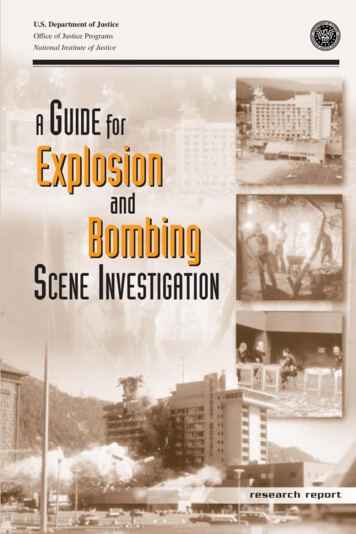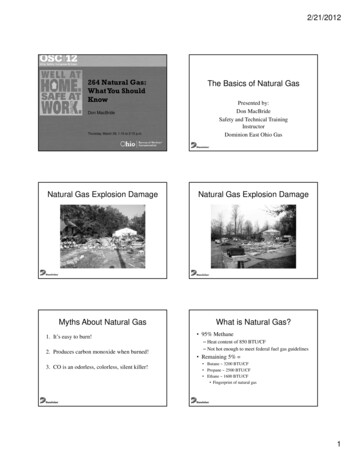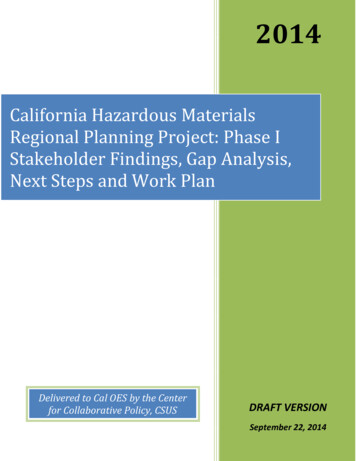
Transcription
U.S. Department of JusticeOffice of Justice ProgramsNational Institute of JusticeAGUIDE forExplosionandBombingSCENE INVESTIGATIONresearch report
U.S. Department of JusticeOffice of Justice Programs810 Seventh Street N.W.Washington, DC 20531Janet RenoAttorney GeneralDaniel MarcusActing Associate Attorney GeneralMary Lou LearyActing Assistant Attorney GeneralJulie E. SamuelsActing Director, National Institute of JusticeOffice of Justice ProgramsWorld Wide Web Sitehttp://www.ojp.usdoj.govNational Institute of JusticeWorld Wide Web Sitehttp://www.ojp.usdoj.gov/nij
About the National Institute of JusticeThe National Institute of Justice (NIJ), a component of the Office of Justice Programs, is theresearch agency of the U.S. Department of Justice. Created by the Omnibus Crime Controland Safe Streets Act of 1968, as amended, NIJ is authorized to support research, evaluation,and demonstration programs, development of technology, and both national and internationalinformation dissemination. Specific mandates of the Act direct NIJ to: Sponsor special projects and research and development programs that will improve andstrengthen the criminal justice system and reduce or prevent crime. Conduct national demonstration projects that employ innovative or promisingapproaches for improving criminal justice. Develop new technologies to fight crime and improve criminal justice. Evaluate the effectiveness of criminal justice programs and identify programs thatpromise to be successful if continued or repeated. Recommend actions that can be taken by Federal, State, and local governments as wellas by private organizations to improve criminal justice. Carry out research on criminal behavior. Develop new methods of crime prevention and reduction of crime and delinquency.In recent years, NIJ has greatly expanded its initiatives, the result of the Violent CrimeControl and Law Enforcement Act of 1994 (the Crime Act), partnerships with other Federalagencies and private foundations, advances in technology, and a new international focus.Examples of these new initiatives include: Exploring key issues in community policing, violence against women, violence withinthe family, sentencing reforms, and specialized courts such as drug courts. Developing dual-use technologies to support national defense and local law enforcementneeds. Establishing four regional National Law Enforcement and Corrections TechnologyCenters and a Border Research and Technology Center. Strengthening NIJ’s links with the international community through participation in theUnited Nations network of criminological institutes, the U.N. Criminal Justice Information Network, and the NIJ International Center. Improving the online capability of NIJ’s criminal justice information clearinghouse. Establishing the ADAM (Arrestee Drug Abuse Monitoring) program—formerly the DrugUse Forecasting (DUF) program—to increase the number of drug-testing sites and studydrug-related crime.The Institute Director establishes the Institute’s objectives, guided by the priorities of theOffice of Justice Programs, the Department of Justice, and the needs of the criminal justicefield. The Institute actively solicits the views of criminal justice professionals and researchersin the continuing search for answers that inform public policymaking in crime andjustice.To find out more about the National Institute of Justice,please contact:National Criminal Justice Reference Service,P.O. Box 6000Rockville, MD 20849–6000800–851–3420e-mail: askncjrs@ncjrs.orgTo obtain an electronic version of this document, access the NIJ Web htm).If you have questions, call or e-mail NCJRS.
A Guide for Explosion andBombing Scene InvestigationWritten and Approved by theTechnical Working Group for Bombing Scene InvestigationJune 2000NCJ 181869
Julie E. SamuelsActing DirectorDavid G. Boyd, Ph.D.Deputy DirectorRichard M. Rau, Ph.D.Project MonitorOpinions or points of view expressed in this document represent aconsensus of the authors and do not necessarily reflect the officialposition of the U.S. Department of Justice.The National Institute of Justice is a component of the Office ofJustice Programs, which also includes the Bureau of Justice Assistance,the Bureau of Justice Statistics, the Office of Juvenile Justice andDelinquency Prevention, and the Office for Victims of Crime.
Message From the Attorney GeneralThe investigation conducted at the scene of an explosion or bombingplays a vital role in uncovering the truth about the incident. Theevidence recovered can be critical in identifying, charging, and ultimatelyconvicting suspected criminals. For this reason, it is absolutely essentialthat the evidence be collected in a professional manner that will yieldsuccessful laboratory analyses. One way of ensuring that we, as investigators, obtain evidence of the highest quality and utility is to followsound protocols in our investigations.Recent cases in the criminal justice system have brought to light the needfor heightened investigative practices at all crime scenes. In order to raisethe standard of practice in explosion and bombing investigations of bothsmall and large scale, in both rural and urban jurisdictions, the NationalInstitute of Justice teamed with the National Center for Forensic Scienceat the University of Central Florida to initiate a national effort. Togetherthey convened a technical working group of law enforcement and legalpractitioners, bomb technicians and investigators, and forensic laboratoryanalysts to explore the development of improved procedures for theidentification, collection, and preservation of evidence at explosion andbombing scenes.This Guide was produced with the dedicated and enthusiastic participation of the seasoned professionals who served on the Technical WorkingGroup for Bombing Scene Investigation. These 32 individuals broughttogether knowledge and practical experience from Federal law enforcement agencies—as well as from large and small jurisdictions across theUnited States—with expertise from national organizations and abroad.I applaud their efforts to work together over the course of 2 years indeveloping this consensus of recommended practices for public safetypersonnel.iii
In developing its investigative procedures, every jurisdiction should givecareful consideration to those recommended in this Guide and to its ownunique local conditions and logistical circumstances. Although factorsthat vary among investigations may call for different approaches or evenpreclude the use of certain procedures described in the Guide, consideration of the Guide’s recommendations may be invaluable to a jurisdiction shaping its own protocols. As such, A Guide for Explosion andBombing Scene Investigation is an important tool for refining investigative practices dealing with these incidents, as we continue our searchfor truth.Janet Renoiv
Message From the President of the University ofCentral FloridaThe University of Central Florida (UCF) is proud to take aleading role in the investigation of fire and explosion scenesthrough the establishment of the National Center for Forensic Science(NCFS). The work of the Center’s faculty, staff, and students, in cooperation with the National Institute of Justice (NIJ), has helped producethe NIJ Research Report A Guide for Explosion and Bombing SceneInvestigation.More than 150 graduates of UCF’s 25-year-old program in forensicscience are now working in crime laboratories across the country. Ourprogram enjoys an ongoing partnership with NIJ to increase knowledgeand awareness of fire and explosion scene investigation. We anticipatethat this type of mutually beneficial partnership between the university,the criminal justice system, and private industry will become even moreprevalent in the future.As the authors of this Guide indicate, the field of explosion and bombinginvestigation lacks nationally coordinated investigative protocols. NCFSrecognizes the need for this coordination. The Center maintains andupdates its training criteria and tools so that it may serve as a nationalresource for public safety personnel who may encounter an explosionor bombing scene in the line of duty.I encourage interested and concerned public safety personnel to use AGuide for Explosion and Bombing Scene Investigation. The proceduresrecommended in the Guide can help to ensure that more investigationsare successfully concluded through the proper identification, collection,and examination of all relevant forensic evidence.Dr. John C. Hittv
Technical Working Group for Bombing Scene InvestigationThe Technical Working Group for Bombing Scene Investigation(TWGBSI) is a multidisciplinary group of content area expertsfrom the United States, Canada, and Israel, each representing his or herrespective agency or practice. Each of these individuals is experienced inthe investigation of explosions, the analysis of evidence gathered, or theuse in the criminal justice system of information produced by the investigation. They represent such entities as fire departments, law enforcementagencies, forensic laboratories, private companies, and governmentagencies.At the outset of the TWGBSI effort, the National Institute of Justice(NIJ) and the National Center for Forensic Science (NCFS) created theNational Bombing Scene Planning Panel (NBSPP)—composed of distinguished law enforcement officers, representatives of private industry, andresearchers—to define needs, develop initial strategies, and steer the largergroup. Additional members of TWGBSI were then selected from recommendations solicited from NBSPP; NIJ’s regional National Law Enforcement and Corrections Technology Centers; and national organizations andagencies such as the Federal Bureau of Investigation, the Bureau of Alcohol,Tobacco and Firearms, the American Society of Crime Laboratory Directors, and the National District Attorneys Association.Collectively, over a 2-year period, the 32 members of TWGBSI listedbelow worked together to develop this handbook, A Guide for Explosionand Bombing Scene Investigation.National Bombing Scene Planning Panel of TWGBSIJoan K. AlexanderOffice of the Chief State’sAttorneyRocky Hill, ConnecticutRoger E. BroadbentVirginia State PoliceFairfax, VirginiaJohn A. Conkling, Ph.D.American PyrotechnicsAssociationChestertown, Marylandvii
Sheldon DickieRoyal Canadian MountedPoliceGloucester, Ontario, CanadaRonald L. KellyFederal Bureau ofInvestigationWashington, D.C.Jimmie C. Oxley, Ph.D.University of Rhode IslandKingston, Rhode IslandRoger N. PrescottAustin Powder CompanyCleveland, OhioJames C. RonayInstitute of Makers ofExplosivesWashington, D.C.Carl VasilkoBureau of Alcohol, Tobaccoand FirearmsWashington, D.C.Raymond S. VoorheesU.S. Postal Inspection ServiceDulles, VirginiaJames T. ThurmanEastern Kentucky UniversityRichmond, KentuckyTechnical Working Group for Bombing SceneInvestigationAndrew A. ApollonyFederal Bureau ofInvestigationQuantico, VirginiaMichael BoxlerBureau of Alcohol, Tobaccoand FirearmsSt. Paul, MinnesotaSteven G. BurmeisterFederal Bureau ofInvestigationWashington, D.C.Gregory A. CarlFederal Bureau ofInvestigationWashington, D.C.Stuart W. CaseForensic Consulting ServicesPellston, MichiganLance ConnorsHillsborough County Sheriff’sOfficeTampa, FloridaJames B. CrippinColorado Bureau ofInvestigationPueblo, ColoradoviiiJohn E. DruganMassachusetts State PoliceSudbury, MassachusettsDirk HedglinGreat Lakes Analytical, Inc.St. Clair Shores, MichiganLarry HendersonKentucky State PoliceLexington, KentuckyThomas H. Jourdan, Ph.D.Federal Bureau ofInvestigationWashington, D.C.Frank MalterBureau of Alcohol, Tobaccoand FirearmsWashington, D.C.Thomas J. MohnalFederal Bureau ofInvestigationWashington, D.C.David S. ShatzerBureau of Alcohol, Tobaccoand FirearmsWashington, D.C.Patricia Dawn SorensonNaval Criminal InvestigativeServiceSan Diego, CaliforniaFrank J. TabertInternational Association ofBomb Technicians andInvestigatorsFranklin Square, New YorkCalvin K. WalbertChemical Safety and HazardInvestigation BoardWashington, D.C.Leo W. WestFederal Bureau ofInvestigationWashington, D.C.Carrie WhitcombNational Center for ForensicScienceOrlando, FloridaDavid M. WilliamsLockheed Martin EnergySystemsOak Ridge, TennesseeJehuda Yinon, Ph.D.Weizmann Institute of ScienceRehovot, Israel
AcknowledgmentsThe National Institute of Justice (NIJ) acknowledges, with greatthanks, the members of the Technical Working Group for BombingScene Investigation (TWGBSI) for their extensive efforts on this projectand their dedication to improving the level of explosion and bombinginvestigations for the good of the criminal justice system. Each of the 32members of this network of experts gave their time and expertise to draftand review the Guide, providing feedback and perspective from a varietyof disciplines and from all areas of the United States, Canada, and Israel.The true strength of this Guide is derived from their commitment todevelop procedures that could be implemented across the country, fromrural townships to metropolitan areas. In addition, thanks are extendedto the agencies and organizations the Technical Working Group (TWG)members represent for their flexibility and support, which enabled theparticipants to see this project to completion.NIJ is immensely grateful to the National Center for Forensic Science(NCFS) at the University of Central Florida, particularly Director CarrieWhitcomb and Project Coordinator Joan Jarvis, for its coordination ofthe TWGBSI effort. NCFS’s support in planning and hosting the TWGmeetings, as well as the support of its staff in developing the Guide,made this work possible.Additionally, thanks are extended to all the individuals, agencies, andorganizations across the country who participated in the review of thisGuide and provided valuable comments and input. In particular, thanksgo to the Bureau of Alcohol, Tobacco and Firearms, the Federal Bureauof Investigation, the National District Attorneys Association, the American Society of Crime Laboratory Directors, the International Association of Arson Investigators, and the International Association of BombTechnicians and Investigators. While all review comments were givencareful consideration by the TWG in developing the final document, thereview by these organizations is not intended to imply their endorsementof the Guide.ix
NIJ would like to thank the co-manager for this project, KathleenHiggins, for her advice and significant contribution to the developmentof the Guide.Special thanks go to former NIJ Director Jeremy Travis for his supportand guidance and to Lisa Forman, Lisa Kaas, and Anjali Swienton fortheir contributions to the TWG program. Thanks also go to Rita Premoof Aspen Systems Corporation, who provided tireless work editing andre-editing the various drafts of the Guide.Finally, NIJ would like to acknowledge Attorney General Janet Reno,whose support and commitment to the improvement of the criminaljustice system made this work possible.x
ContentsMessage From the Attorney General . iiiMessage From the President of the University of Central Florida . vTechnical Working Group for Bombing Scene Investigation . viiAcknowledgments . ixIntroduction . 1Purpose and Scope . 1Statistics on Bombings and Other Explosives-Related Incidents . 2Background . 4Training . 8Authorization . 8A Guide for Explosion and Bombing Scene Investigation . 9Section A. Procuring Equipment and Tools . 11Safety . 11General Crime Scene Tools/Equipment . 12Scene Documentation . 12Evidence Collection . 13Specialized Equipment . 14Section B. Prioritizing Initial Response Efforts . 151. Conduct a Preliminary Evaluation of the Scene . 152. Exercise Scene Safety . 163. Administer Lifesaving Efforts . 174. Establish Security and Control. 17xi
Section C. Evaluating the Scene . 191. Define the Investigator Role . 192. Ensure Scene Integrity . 203. Conduct the Scene Walkthrough . 214. Secure Required Resources. 21Section D. Documenting the Scene . 231. Develop Written Documentation . 232. Photograph/Videotape the Scene . 233. Locate and Interview Victims and Witnesses . 24Section E. Processing Evidence at the Scene . 271. Assemble the Evidence Processing Team . 272. Organize Evidence Processing . 283. Control Contamination . 284. Identify, Collect, Preserve, Inventory, Package, andTransport Evidence . 29Section F. Completing and Recording the Scene Investigation . 331. Ensure That All Investigative Steps Are Documented . 332. Ensure That Scene Processing Is Complete . 343. Release the Scene . 354. Submit Reports to the Appropriate National Databases . 35Appendix A. Sample Forms . 37Appendix B. Further Reading . 47Appendix C. List of Organizations . 49Appendix D. Investigative and Technical Resources . 51xii
Introduction“I had imagined that Sherlock Holmes would have at once hurriedinto the house and plunged into a study of the mystery. Nothingappeared to be further from his intention. He lounged up anddown the pavement and gazed vacantly at the ground, the sky, theopposite houses. Having finished his scrutiny, he proceeded slowlydown the path, keeping his eyes riveted on the ground.”Dr. WatsonA Study in ScarletSir Arthur Conan DoyleSherlock Holmes, the master of detectives, considered it essential to beexcruciatingly disciplined in his approach to looking for evidence at acrime scene. While it is imperative that all investigators apply disciplinein their search for evidence, it is apparent that few do so in the same way.Currently, there are no nationally accepted guidelines or standard practicesfor conducting explosion or bombing scene investigations. Professionaltraining exists through Federal, State, and local agencies responsible forthese investigations, as well as through some organizations and academicinstitutions. The authors of this Guide strongly encourage additionaltraining for public safety personnel.Purpose and ScopeThe principal purpose of this Guide is to provide an investigative outlineof the tasks that should be considered at every explosion scene. They willensure that proper procedures are used to locate, identify, collect, andpreserve valuable evidence so that it can be examined to produce themost useful and effective information—best practices. This Guide wasdesigned to apply to explosion and bombing scene investigations, fromhighly complex and visible cases, such as the bombing of the Alfred P.Murrah Federal Building in Oklahoma City, to those that attract lessattention and fewer resources but may be just as complex for the investigator. Any guide addressing investigative procedures must ensure that1
each contributor of evidence to the forensic laboratory system is servedby the guide and that quality examinations will be rendered. Consistentcollection of quality evidence in bombing cases will result in moresuccessful investigations and prosecutions of bombing cases. Whilethis Guide can be useful to agencies in developing their own procedures,the procedures included here may not be deemed applicable in everycircumstance or jurisdiction, nor are they intended to be all-inclusive.Statistics on Bombings and OtherExplosives-Related IncidentsThe principal Federal partners in the collection of data related to explosives incidents in the United States are the Bureau of Alcohol, Tobaccoand Firearms (ATF), the Federal Bureau of Investigation (FBI), the U.S.Postal Inspection Service (USPIS), and the U.S. Fire Administration(USFA). These Federal partners collect and compile information supplied by State and local fire service and law enforcement agenciesthroughout the United States and many foreign countries.According to ATF and FBI databases, there were approximately 38,362explosives incidents from 1988 through 1997 (the latest year for whichcomplete data were available) in the United States, including Guam,Puerto Rico, and the U.S. Virgin Islands. Incident reports received byATF and the FBI indicate that the States with the most criminal bombingincidents are traditionally California, Florida, Illinois, Texas, and Washington. Criminal bombings and other explosives incidents have occurredin all States, however, and the problem is not limited to one geographicor demographic area of the country.The number of criminal bombing incidents (bombings, attemptedbombings, incendiary bombings, and attempted incendiary bombings)reported to ATF, the FBI, and USPIS fluctuated in the years 1993–97,ranging between 2,217 in 1997 and 3,163 in 1994. Incendiary incidentsreached a high of 725 in both 1993 and 1994. Explosives incidents2
reached a high of 2,438 in 1994 and a low of 1,685 in 1997. It is important to note that these numbers reflect only the incidents reported toFederal databases and do not fully reflect the magnitude of the problemin the United States.Of the criminal bombing incidents reported during 1993–97, the topthree targets—collectively representing approximately 60 percent ofthe incidents—were residential properties, mailboxes, and vehicles.Motives are known for about 8,000 of these incidents, with vandalismand revenge by far cited most frequently.The most common types of explosive/incendiary devices encounteredby fire service and law enforcement personnel in the United States aretraditionally pipe bombs, Molotov cocktails, and other improvisedexplosive/incendiary devices. The most common explosive materialsused in these devices are flammable liquids and black and smokelesspowder.Stolen explosives also pose a significant threat to public safety in theUnited States. From 1993 to 1997, more than 50,000 pounds of highexplosives, low explosives, and blasting agents and more than 30,000detonators were reported stolen. Texas, Pennsylvania, California,Tennessee, and North Carolina led the Nation in losses, but every Statereported losses.Further information, including updated and specific statistical information, can be obtained by contacting the ATF Arson and ExplosivesNational Repository at 800–461–8841 or 202–927–4590, through itsWeb site at http://ows.atf.treas.gov:9999, or by calling the FBI BombData Center at 202–324–2696.3
BackgroundNational Bombing Scene Planning Panel (NBSPP)The National Center for Forensic Science (NCFS) at the University ofCentral Florida (UCF) in Orlando, a grantee of the National Institute ofJustice (NIJ), held a National Needs Symposium on Arson and Explosives in August 1997. The symposium’s purpose was to identify problemareas associated with the collection and analysis of fire and explosiondebris. One of the problem areas identified was the need for improved,consistent evidence recognition and handling procedures.In spring 1998, NIJ and NCFS, using NIJ’s template for creating technical working groups, decided to develop guidelines for fire/arson andexplosion/bombing scene investigations. The NIJ Director selectedmembers for a planning group to craft the explosion/bombing investigation guidelines—NBSPP. At the same time, the NIJ Director selected afire/arson planning panel. The nine NBSPP members represent nationaland international organizations whose constituents are responsible forinvestigating explosion and bombing scenes and evaluating evidencefrom these investigations. The group also includes one academic researcher. The rationale for their involvement was twofold: They represent the diversity of the professional discipline. Each organization is a key stakeholder in the conduct of explosionand bombing investigations and the implementation of this Guide.NBSPP was charged with developing an outline for national guidelinesfor explosion and bombing scene investigations—using the formatin the NIJ publication Death Investigation: A Guide for the SceneInvestigator1 as a template—and identifying the expertise composition ofa technical working group for explosion/bombing scene investigations.This task was completed in March 1998 at a meeting at NCFS; theresults are presented here.4
Technical Working Group for Bombing SceneInvestigation (TWGBSI)Candidates for TWGBSI were recommended by national law enforcement, prosecution, forensic sciences, and bomb technician organizationsand commercial interests and represented a multidisciplinary group ofboth national and international organizations. These individuals are allcontent area experts who serve within the field every day. The followingcriteria were used to select the members of TWGBSI: Each member was nominated/selected for the position by NBSPPand NCFS. Each member had specific knowledge regarding explosion andbombing investigation. Each member had specific experience with the process of explosionand bombing investigation and the outcomes of positive and negativescene investigations. Each member could commit to the project for the entire period.The 32 experts selected as members of TWGBSI came from 3 countries(the United States, Canada, and Israel), 13 States, and the District ofColumbia. Because this technical working group dealt with explosionand bombing scenes, a large portion of investigators and analysts represented ATF and the FBI. The geographical distribution of TWGBSImembers is shown in exhibit 1.Chronology of WorkNBSPP meeting. In March 1998, the panel met at UCF, under the sponsorship of NCFS, to review the existing literature and technologies, preparethe project objectives, and begin the guideline development process. Thepanel’s objective was to develop an outline for a set of national guidelinesbased on existing literature and present them for review to the assembledTWGBSI at a later date. During this initial session, five investigative taskswere identified. Each task included subsections that, when developed,provided a template of procedures for investigators to follow whileconducting an explosion or bombing investigation.5
Exhibit 1. Technical Working Group for Bombing Scene InvestigationMembership DistributionCanadaIsraelNortheastSoutheastRocky MountainLaw EnforcementProsecutorsLaboratory StaffResearchersWestPractitionersRegionNumber of ParticipantsNortheast20SoutheastRocky MountainWest811International2The completed Guide includes the following components: A principle citing the rationale for performing the task. The procedure for performing the task. A summary outlining the principle and procedure.TWGBSI assembled in August 1998. After introductory remarks fromthe president of UCF, TWGBSI separated into five breakout sections todraft the Guide, which includes the following stages: Prioritizing initial response efforts. Evaluating the scene.6
Documenting the scene. Processing evidence at the scene. Completing and recording the scene investigation.Once all breakout groups completed their work, the full group reassembled to review and approve the initial draft. Editors from an NIJcontractor attended each section to record the proceedings and guidethe editorial process. After the meeting, the editors reformatted theinitial draft and forwarded it to an agency representative so that itcould be sent to all TWGBSI members for comment.Organizational review and national reviewer network. After theTWGBSI comments were received by NIJ, NBSPP met in Novemberand December 1998 in Washington, D.C., to consider and incorporatethe comments, creating the second draft of the Guide. In addition,NBSPP members recommended organizations, agencies, and individualsthey felt should comment on the draft document, which was mailed toall TWGBSI members and to this wider audience in June 1999. The 150organizations and individuals whose comments were solicited duringthe national review of this Guide included all levels of law enforcement,regional and
tion Network, and the NIJ International Center. Improving the online capability of NIJ's criminal justice information clearinghouse. Establishing the ADAM (Arrestee Drug Abuse Monitoring) program—formerly the Drug Use Forecasting (DUF) program—to increase the number of drug-testing sites and study drug-related crime.











